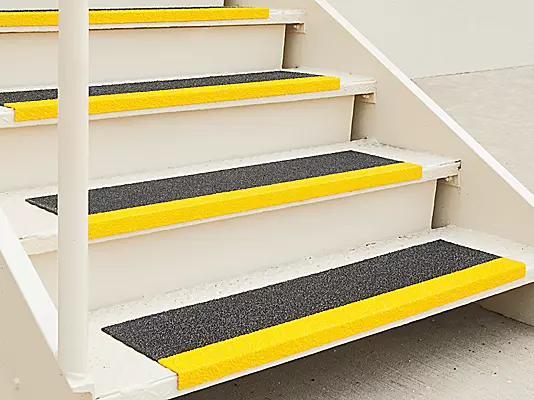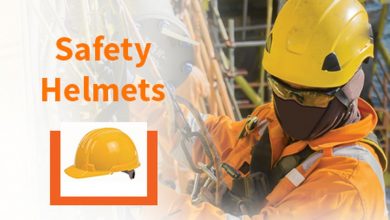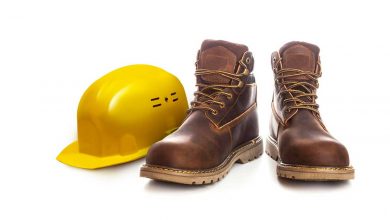Enhancing Operational Safety with Anti-Slip Stair Treads in the Oil and Gas Industry
Anti-Slip Stair Treads in the Oil and Gas Industry

In the high-stakes environment of the oil and gas industry, safety remains a paramount concern. Every aspect of operations, from drilling to transportation, involves potential hazards that can lead to serious accidents. Among these, the risk of slips and falls, particularly on stairways, stands out due to its frequency and preventability. Stairways in these settings often face exposure to elements like oil, chemicals, and varied weather conditions, making them inherently slippery and dangerous.
This is where the role of anti-slip stair treads, anti-slip mats and rubber mats for Oil and Gas industry in Dubai becomes crucial. These safety installations are designed not just to reduce the risk of accidents but to actively promote a safer working environment. By enhancing grip and stability, they offer a straightforward yet effective solution to one of the industry’s most common safety challenges. As we delve deeper into this topic, we’ll explore the various facets of anti-slip stair treads, from their importance in ensuring safety to compliance with industry standards.
The Importance of Stair Safety in the Oil and Gas Industry
Navigating the labyrinth of pipes, platforms, and equipment in oil and gas facilities poses significant risks, particularly when it comes to stairways. These environments are rife with potential hazards that can compromise stair safety. The presence of hydrocarbons, for instance, can create exceptionally slippery surfaces, increasing the likelihood of falls. Additionally, outdoor staircases are often subject to harsh weather conditions, like rain or snow, further exacerbating the slip risk.
The consequences of stair-related accidents in the oil and gas sector can be severe. From minor injuries to fatalities, the human cost is substantial. Beyond the personal toll, these accidents also impact operational efficiency. They can lead to lost workdays, decreased morale, and potential legal liabilities.
Recent statistics underline the severity of the issue. According to the Occupational Safety and Health Administration (OSHA), slips, trips, and falls constitute the majority of general industry accidents, with stairways being a common site for these incidents. In the oil and gas industry, where the environment is more hazardous, the risks are even higher, making stair safety a priority.
In this context, anti-slip stair treads are not just an optional safety feature but a necessity. They provide a proactive approach to reducing the risk of accidents, ensuring that workers can navigate facilities safely. By prioritizing stair safety, companies in the oil and gas sector can protect their employees and maintain operational efficiency.
Features of High-Quality Anti-Slip Stair Treads
In the demanding environment of the oil and gas industry, not all anti-slip solutions are equal. High-quality anti-slip stair treads must possess certain features to effectively counter the unique challenges of this sector. Understanding these key characteristics can guide facilities in making informed decisions when selecting and installing these safety components.
- Material and Durability
The choice of material is crucial for anti-slip stair treads. Materials like heavy-duty rubber and industrial-grade metal alloys are popular due to their durability and resistance to corrosive substances commonly found in oil and gas settings. These materials can withstand extreme weather conditions and heavy foot traffic, ensuring longevity and consistent performance.
- Design and Traction
The design of the tread surface plays a vital role in preventing slips. Treads with aggressive, non-slip patterns provide superior grip, even when exposed to oil, water, or mud. The design should also allow for easy drainage of liquids, preventing the buildup of slippery substances.
- Resistance Properties
Resistance to oil, chemicals, and extreme temperatures is a must. Anti-slip treads designed for the oil and gas industry should be able to maintain their integrity and grip in a variety of harsh conditions, including exposure to various hydrocarbons and extreme cold or heat.
- Visibility
Good visibility is often an overlooked aspect of stair tread design. Treads with high-visibility elements, like photoluminescent or brightly colored markings, can significantly enhance safety, especially in low-light conditions common in many oil and gas facilities.
Selecting anti-slip stair treads with these features ensures not only the safety of personnel but also aligns with the industry’s rigorous operational standards. By investing in quality solutions, companies can create a safer working environment, reducing the risk of accidents and enhancing overall facility safety.
Installation and Maintenance of Anti-Slip Stair Treads
Implementing anti-slip stair treads is a proactive step towards enhanced safety in oil and gas facilities. However, their effectiveness largely depends on proper installation and maintenance. Adhering to best practices in these areas ensures that the stair treads perform optimally under the challenging conditions of this industry.
- Proper Installation Techniques
The installation process begins with selecting the right size and type of tread for each specific staircase. Treads must cover the entire step surface to provide comprehensive protection. It’s essential to prepare the stair surfaces by cleaning them thoroughly and ensuring they are dry and free of debris. When installing, use high-quality adhesives or mechanical fasteners, depending on the tread type and material of the stairs. This ensures a secure fit that can withstand heavy usage and exposure to harsh elements.
- Regular Maintenance Practices
Regular maintenance is key to preserving the functionality and safety of anti-slip stair treads. Inspect the treads periodically for signs of wear, damage, or loosening. In environments like oil and gas facilities, where exposure to corrosive substances is common, more frequent checks are advisable. Cleaning the treads regularly to remove oil, grease, and other contaminants also maintains their anti-slip efficacy. Use appropriate cleaning agents that do not degrade the tread material.
Compliance and Industry Standards for Anti-Slip Stair Treads
Adherence to compliance and industry standards is a critical aspect of implementing anti-slip stair treads in the oil and gas industry. These standards are not only legal requirements but also benchmarks for ensuring the highest level of safety in challenging industrial environments.
- Meeting OSHA and Industry Regulations
The Occupational Safety and Health Administration (OSHA) sets forth guidelines that are particularly relevant to stair safety. OSHA standard 1910.24 stipulates specific requirements for stairways used in industrial settings, including aspects like tread depth, riser height, and the necessity for slip-resistant surfaces. Complying with these standards by the anti-slip mat supplier in Dubai or operating company is crucial for legal compliance and worker safety.
- Beyond Compliance: Adopting Best Practices
While meeting regulatory standards is essential, the best approach in the high-risk oil and gas sector is to exceed them. This involves choosing anti-slip stair treads that are designed with the unique challenges of this industry in mind. Products that offer superior slip resistance, durability under extreme conditions, and enhanced visibility go beyond the minimum requirements, setting a higher standard for workplace safety.
- Certification and Quality Assurance
Selecting certified anti-slip stair treads is another critical step. Products that have undergone rigorous testing and have certifications from recognized safety organizations offer an added assurance of quality and compliance. These certifications often indicate that the treads have been tested for various factors such as slip resistance, load capacity, and environmental resilience.
Elevating Safety in the Oil and Gas Industry with Trax Anti-Slip Solutions
The implementation of anti-slip stair treads is an indispensable safety measure in the oil and gas industry. As we have explored, these treads not only significantly reduce the risk of slips and falls but also enhance overall operational safety. From the selection of high-quality materials and designs tailored for harsh industrial environments to the adherence to stringent installation and maintenance practices, every step ensures that stairways in oil and gas facilities are as safe as possible.
For those looking to implement or upgrade their anti-slip stair solutions, Takmeel Trading oil and gas suppliers in UAE offer an excellent option. By ordering the Trax Antislip Products Australia from Takmeel Trading, you are choosing quality and reliability. Contact us via call: +971 52 692 2575 or email: info@takmeeltrading.com and invest in the safety of your facilities and personnel by choosing the right anti-slip stair treads.




